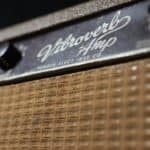Guitars’ looks are relevant features.
It is not the main concern, since sound and playability are more important.
However, who doesn’t want a guitar that looks glorious?
For this, some people paint their guitars at home.
It might be worth asking whether spray paint could suit this situation or not?
After all, will I find pleasant results if I spray paint my guitar?
Yes, you can apply spray paint to a guitar. While many prefer sticking with alternatives such as polyester paint, there won’t be negative consequences if you spray paint the instrument. Always follow the right procedure to ensure a successful outcome.
Below you’ll find more information regarding this topic, as well as some alternatives, advice, and prevention methods.
Prevention for what, you may ask? Keep reading to find it out!
Will spray paint work on a guitar?
If you have a spray can gathering dust in a corner of your garage, then go and grab it.
The good news is, you can add spray paint to a guitar without any side effects.
You should be careful, though, regarding certain minute details that could ruin your work.
Spray paint can drip, or dust particles could get sticked in the guitar.
Still, there’s a simple solution to this issue: apply yet another layer of spray paint.
A final piece of advice: always check that the spray you are working with can be used in wood.
While most of them do work and stick to wood, a quick check to prevent problems is encouraged.
Best spray paint for guitars
The type of spray paint you use won’t make a difference.
Any spray paint works.
It is fair to notice that some people claim hard finishes cannot work well with regular spray paint.
Still, it doesn’t mean it’s impossible.
Some others recommend using a Krylon spray can since it resembles professional paint.
Spray cans with adjustable fan tips are also endorsed, such as Duplicolor automotive paint.
Bear in mind that you might prefer painting your guitar with acrylic paint. After all, they tend to be a number one selection.
If not, then any paint made from polyester, nitrocellulose, or polyurethane will be ok.
Can you spray paint guitar hardware?
For the most part, painting guitar parts is not an intelligent idea.
This is because the paint is most likely not to stick, especially if we talk about long-term duration.
Paint is bound to break away from metal parts unless you use a baked enamel finish.
What is more, paint can clog your gear. This is dangerous because the gear can stop working properly.
What you can paint with spray cans are guitar strings, since they don’t have any mechanism that could be ruined.
The best advice I can give is to leave any small detail to a professional.
Instead, focus solely on the guitar’s body.
Can you spray paint a guitar’s neck?
I’ll encourage you to forget about painting the guitar’s neck.
First of all, bonding the paint to the neck is no easy task unless you are a professional painter. It would take you tens of paint layers to get a pleasant result.
Still, even if you succeed in painting it, there’s a second issue you’ll have to deal with.
I’m talking about the feel and the playability.
With a painted neck, the smoothness of your playing will disappear. The fretboard will be sticky and reduce your fingers’ agility.
Once again, it is better to dye other guitar parts. Leave the neck’s natural color, the other option is not worthy.
Do you need to prep a guitar before spray painting it?
There’s a specific procedure that you should follow before spray painting your instrument.
To ensure a long-time quality lifespan, the process is the following.
You start by removing the neck, the strings, knobs, and electrical components that connect the bridge and pickups.
Then, with a dryer, apply some heat to the guitar’s body to soften the old paint. Use a putty knife to lift off the paint.
Once you are done, sand the guitar’s body, including the edges and every side.
An extra but recommended step is to fill divots with an automotive filler, then let them dry between 20 and 30 minutes. Before jumping to the next step, sand the automotive filler as well.
Lastly, gather every dust particle you find on your guitar with a dry cloth. Wiping over the surface prevents unwanted dust from getting sealed into the paint.
That’s it! You have prepared your instrument for a painting session.
Will spray paint damage a guitar?
It is not possible to damage a guitar by applying spray paint.
Bear in mind that this process is not rare, and many musicians have done it throughout the years without encountering difficulties.
However, if we talk about damages, then it is more likely that it will affect you more than your guitar.
Let me explain it.
Spray paint has certain particles that can create both short-term and long-term issues for your health.
We’ll focus solely on the short-term ones since you are probably not spray painting 24/7.
Short-termed side effects include eye, throat, and nose irritation. It can also cause nausea or headaches.
Take it easy. If you experience one of them, they will disappear eventually.
Still, I strongly recommend you wear the proper safety equipment, such as a mask, a pair of glasses, or both.
Will spray paint last on a guitar?
Spray paint is meant to last, although there are specific sections that will be more likely to come off.
The more you play, the more friction you apply to certain parts with your wrists and arms.
Continual rubbing with sweat tends to take the paint off.
However, it takes some time for this to start happening.
Plus, you can always add a brand new spray layer to the body.
Can you remove spray paint from a guitar?
As stated above, the arm’s sweat can remove the guitar’s finish.
Now, it would take you ages to clean everything out with your arms moisture.
And to be honest… who would ever consider doing that!?
But seriously, there are real (and logical) methods for this.
We covered them in the previous section, regarding the use of a heater, a putty knife, and sandpaper.
In addition, one could use a WD-40, but be careful with it.
Nitro finishes get damaged by this oil, and poly finishes might stain. However, in wax finishes the wood can be damaged.
I do recommend the previous alternative, with the drying gun and the sanding.
It’s time demanding, but it’s worthy of it.
Do you need to lacquer a guitar after spray painting it?
It is not mandatory, but it could work.
A coat of varnish or lacquer is a good idea if you are looking for the paint to last longer.
Many guitarists lacquer their guitars because, in the long run, it provides a vintage-like style.
Guitars acquire a patina over time, having certain patterns of wear and tear, that make them look both old and beautiful.
What are some alternatives to spray painting a guitar?
Alternatives are always worth mentioning.
The first thing that comes to our minds, is to apply a different type of paint, such as acrylic or polyester paint.
You can try out oil finishes too.
What is more, you could also buy a guitar’s skin of your preference and apply it to the body.
Many skins come with fantastic patterns that make your guitar look really good.
Lastly, it’s not a bad idea to add stickers to the guitar.
Many guitarists don’t like this alternative, and it is understood.
Now, if you are not one of them, then buy a handful of them and place them all over the body.

Hello there, my name is Ramiro and I’ve been playing guitar for almost 20 years. I’m obsessed with everything gear-related and I thought it might be worth sharing it. From guitars, pedals, amps, and synths to studio gear and production tips, I hope you find what I post here useful, and I’ll try my best to keep it entertaining also.





